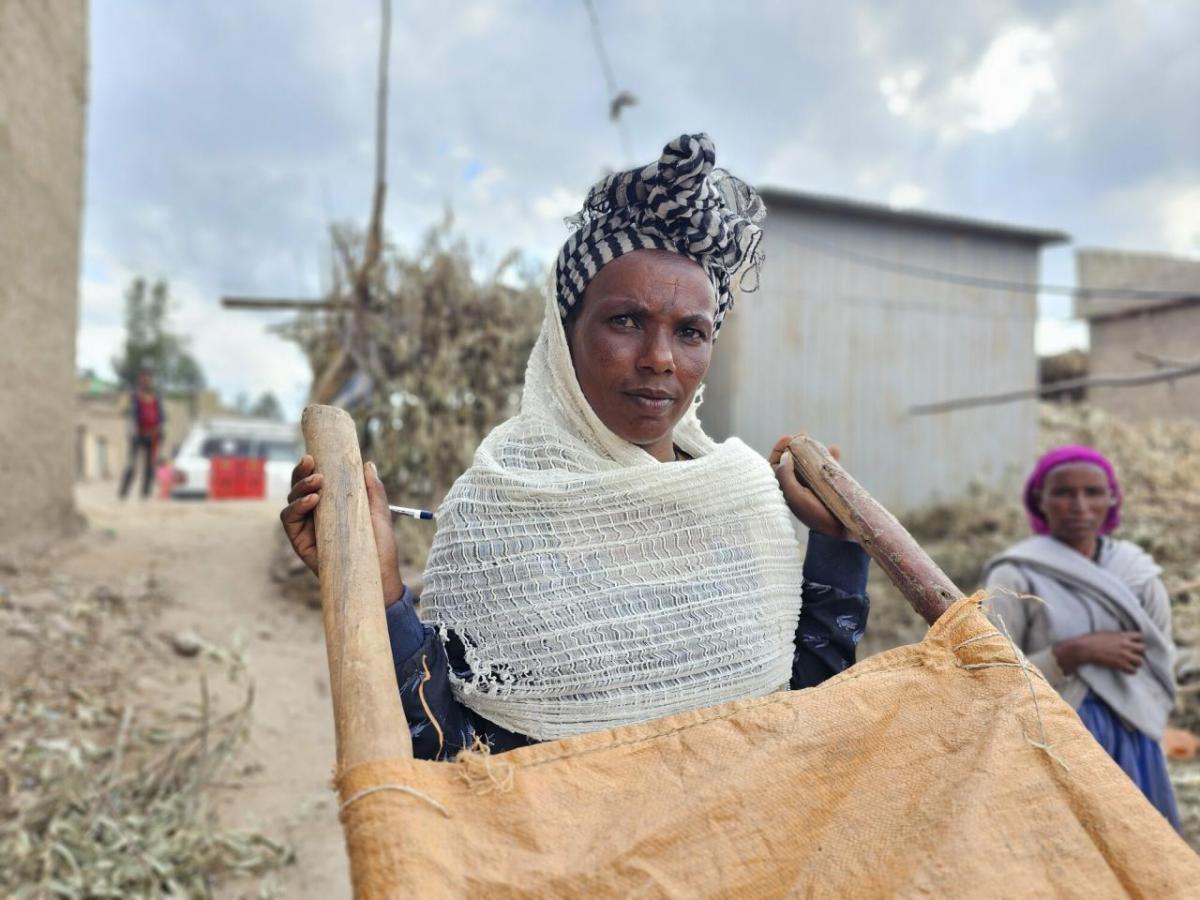Fighting for Maternal Health in Ethiopia With Two Sticks and Fertilizer Sacks

CARE News & Stories is where to find out what's happening around the world through vibrant, engaging stories that put humanity at the center. http://www.care.org/news-and-stories/category/news/
Kahsa grabs the two long wooden sticks from her neighbor’s storage and starts running.
The sticks, originally used to transport fertilizer, are tied together with old linen sacks.
Kasha is running because one of her neighbors is giving birth, and, because of the recent conflict in the region, this, the old traditional way of transporting patients, is how Kasha helps get mothers to the clinic to deliver their babies as safely as possible.
She uses two sticks and a sack for the patient to lie down on, and then two people to carry the precious cargo. It takes about thirty minutes to get to the clinic this way.
“We are trying our best to reduce the number of home births,” says the 34-year-old. “But it is so difficult without an ambulance service.”
Before the conflict, 90% of mothers in Tigray received prenatal care, and more than 70% benefited from skilled deliveries, according to an analysis by health experts .
“We almost reduced deliveries of mothers at home to zero in our village before the conflict because we were all active in raising awareness on the risks of home deliveries,” explains Kasha. “However, during the conflict we had no access to the clinic because it was closed due to damage and too dangerous to go anywhere else.”
Now, this is currently the only way for them to get patients to a clinic.
“A woman from our village died from bleeding when she delivered her baby at home during the conflict,” remembers Kahsa.
Experts warn that delivering at home here is a potentially high risk for the mother and the newborn, because things can go wrong at any stage during childbirth, and the conflict has made access to even the most basic medical care precarious.
The mother could bleed out, endure an obstructed labor causing a fistula, or suffer a seizure.
Kahsa is part of a Women Lead in Emergencies group supported by CARE and our partner in the SELAM project. The group brings together 25 women to discuss gender-related topics such as women in politics, female-led businesses, and violence against women, and to strengthen their voices in the community.
It is relatively safe now that the worst of the conflict is over, but the villagers still have no means to get to the clinic.
“Even after the conflict," Kahsa says, "there still are no medical transportation services. So, in one of our meetings we discussed the high numbers of home deliveries and found a solution together.”
They resorted to the old traditional way of transporting patients, with sticks and cloth.
It’s a working system, but not a replacement for adequate access to health facilities.
“This month a woman lost her baby because it was in a wrong position. I was responsible for getting the stretcher to her, but I was too late to save the baby,” remembers Kahsa.
She herself is a mother of three, so she knows first-hand why access to maternal health is so important.
“My firstborn was a home delivery. I was bleeding a lot, and for three days I could not stand on my own. My family had to carry me everywhere. There was a tear, and it took a lot of time to heal,” she says.
Her second child was born in a clinic.
“My baby had a wrong position, and I had an emergency operation and stayed in the clinic for three months. It saved my life and that of my child,” she says.
The clinic close to Kahsa’s village is in poor condition.
“The clinic was heavily damaged and only open for the last year, but it is lacking supplies. Before the SELAM project it also did not have any access to water, so the women delivering babies had to bring a 5-liter jerrican of water with them for their own treatment,” says Kahsa.
Only 3 percent of health facilities in Tigray have been fully functional since the conflict due to lack of supplies and partial or total damage to facilities. 93 percent of referral facilities lack the basic supplies necessary for providing essential services for pregnant women and newborns .
“We need to do more for mothers,” says Kahsa.
Since the onset of the conflict, the maternal mortality rate in the region has increased fivefold, according to a study by the Regional Health Bureau.
This level is comparable to those of 22 years ago. Most deaths are due to easily preventable causes such as bleeding. More than 80 percent of the mothers died outside of a health facility. Before the conflict, there were less than 200 maternal deaths per 100,000 births in Tigray. Now the average is 840 , which is 210 times higher than the maternal mortality rate in Germany/168 times higher than the maternal mortality rate in Austria .
“The women get pregnant and cannot access care. And if she’s in labor she cannot travel. There are no ambulances and we do not have the money to pay for private transportation. So, what should we do?” asks Kahsa.
And even when they get to a health facility they often cannot be helped.
Kahsa and the women’s leadership group are trying to change that.
“I am trying to support women in my community and to encourage the group to stand up for their rights. Before we were not represented in society. Our husbands were the head and represented us. Now we are part of the decision-making. It was a taboo to speak for the community. Now we speak loudly. We finally have a voice and fight for us mothers.”

